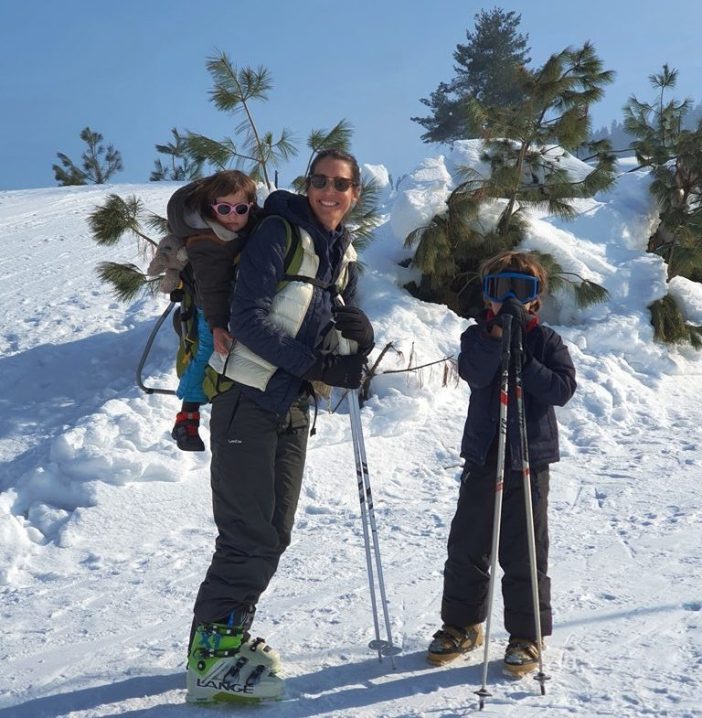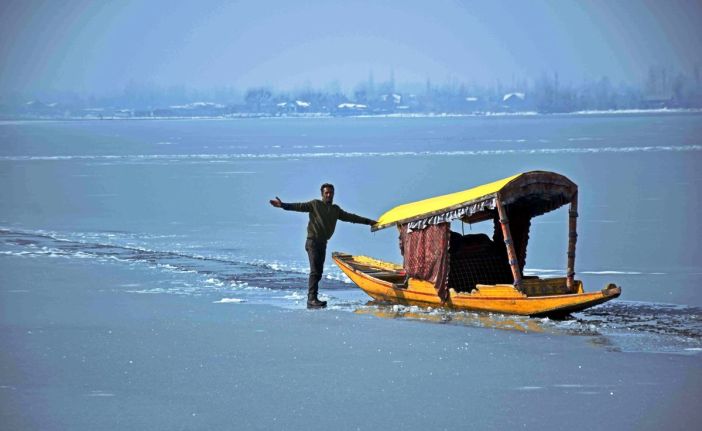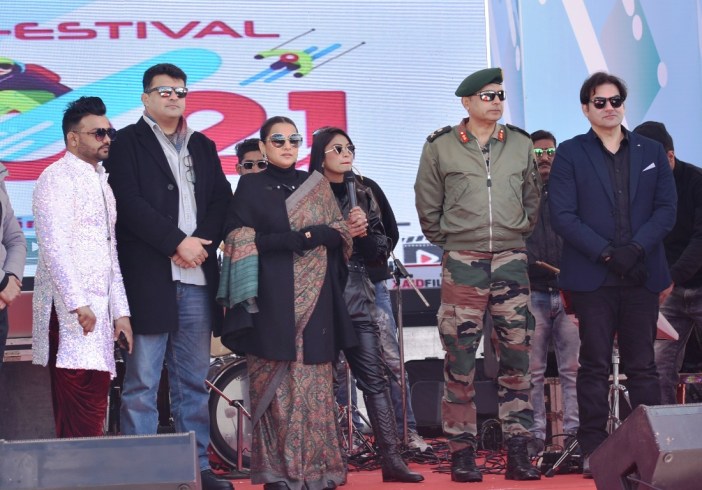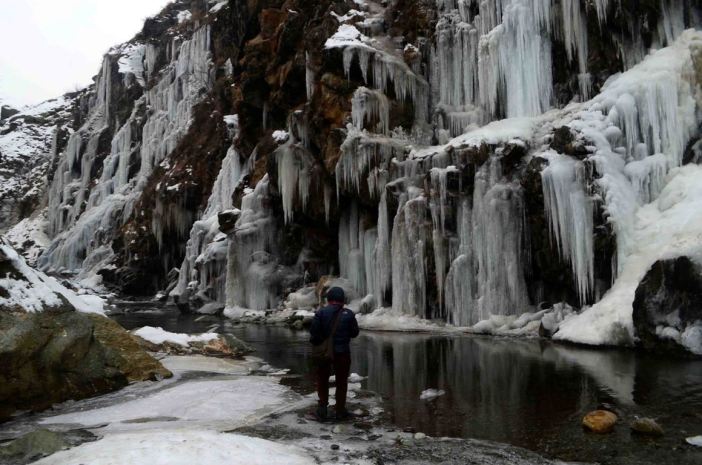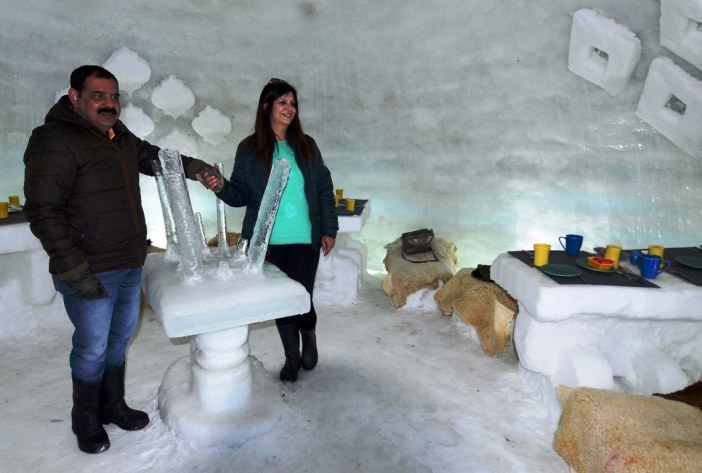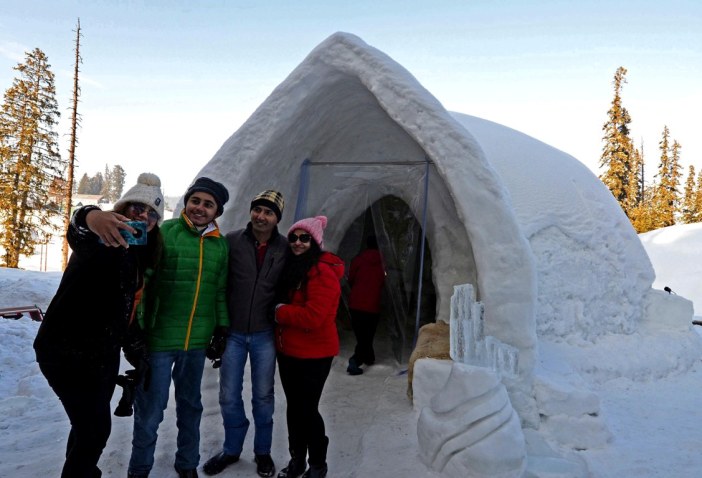After 18 months of hiatus, the tourist footfalls have started surging in Kashmir. Insiders in the hospitality sector believe that if Gulmarg crowds are an indication, Kashmir may have a better tourist year, reports Khalid Bashir Gura
A French mother with her children busy in Skiing in Gulmarg in one of the Kashmir’s coldest winters. Pic: Nasir Khan
The six-month-long lockdown following reading down of Article 370 on August 5, 2019, and the pandemic of 2020 battered the tourism industry in Kashmir. But this winter after a heavy snowfall the tourism industry has started to revive, much to people’s respite whose livelihood is dependent on it.
January witnessed a flurry of domestic tourists flooding places like Gulmarg, Pahalgam and Sonmarg in larger numbers than previous winters. Gulmarg, which is a much-preferred winter destination, remained crowded and busy with unprecedented tourist footfall, promotional events, adventure tourism, Bollywood celebs visits, winter sports, and recreational activities.
Impressive Gulmarg
Javed-ul-Rehman, Assistant Director Tourism, Gulmarg, said that they held tourism promotional activities in many parts of the country, especially after the Covid-19 lockdown was eased since October. Since December, the department also held more than 25 such activities in Kashmir including live musical events, the celebration of New Year, sports events and cultural events.
“
Khelo India conducted by J&K sports council had to change dates three times because of lack of accommodation. The hotels are packed,” Rehman said. He hopes the rush continues through spring and summer.
The tourism department, however, is apprehensive about the sustaining the winter footfalls once the international travel restrictions due to the pandemic are eased.
Officials said last year, 98,757 tourists visited Gulmarg, in which 54, 821 were local, 41,562 domestic and 2374 foreigners. This year, in January alone, a total of 46383 tourists visited the place in which 27452 were locals and 18931 were domestic. No foreign tourists visited the place, according to data.
The hustle and bustle at high altitude health resorts has generated hope among people associated with tourism around Dal Lake in Srinagar whose livelihood has been worst hit due to the successive lockdowns.
Even though vacant houseboats and
Shikaras are anchored on banks waiting in anticipation for tourists, the hope increases with every visitor from outside the Valley.
Sinking Infra
Kashmir’s hospitality sector has been in an uneasy state since 2014 floods, in fact much earlier. It moved between hopes and hoaxes of an early revival but nothing much changed. It was a grand cocktail of weather conditions and the fragile security situation that prevented a good tourist year. Now the pandemic is the reigning crisis.
A boatman poses for a photograph on the frozen Dal Lake on Thursday, January 14, 2021.KL Image by Bilal Bahadur
This has led the professionals to abandon the infrastructure and explore alternatives to survival. Even the hotels and the houseboats are not in a decent shape.
On a balmy February morning, Ghulam Nabi Billo stares at the silver lake from the deck of his vacant houseboat, HB City of Kashmir. He passes his wrinkled fingers through his long white-beard and shifts his tired gaze towards his neighbour’s sunken houseboat and sighs. Billo, recalls, how a few decades ago tourists visited Kashmir in large numbers; large enough to keep him busy and away from musing on his deck and witnessing the desolate silence engulfing the lake. Associated with the industry from his childhood, Billo says he has been idle since August 5, 2019. According to him, the Valley’s “economic back is broken”. But the hope hinges on this year.
“We have been through the tumultuous period of the 1990s, prolonged shutdowns but the tourism continued. But the successive lockdowns have broken our back,” Billo said.
Days before reading down of J&K’s special status the sudden communication clampdown and the adverse government advisory evacuated the Valley of tourists.
“If there are no tourists, there will be no money. Tourist industry money goes into every pocket”, Billo said adding that high spend tourists especially from foreign countries used to visit and spend a lot of money unlike domestic ones from mainland India.
As snow brought tourists dismayed Billo witnessed the sinking of his neighbour’s houseboat. A symbolic representation of Kashmir’s culture, houseboats are sinking as the owners could not afford the mandatory yearly coring of the wood.
“Coring process requires periodic plugging of the gaps between the wooden planks of the houseboat’s floor with a special, dried grass to keep the boat watertight”, said Billo. “Coring costs around Rs 50, 000 to around one lakh depending upon the size and the state of the boat. We have never received any financial support for this from anyone”. At Ghat No 7, the owner of the sunken houseboat which leads to HB Simla, Muhammad Shafi Handoo lives in a
dunga boat now. He has to feed a family of five and unlike other well-off houseboat owners; he feeds his family by driving an auto.
“I could not stare at the vacant houseboat and let my family die of hunger. Whatever we used to earn, we used to spend it on repairs. If we are asked to rehabilitate and given land somewhere we will shift,” Handoo said adding, that the loss of income has impacted the education of his children. For how long will we keep feeding ourselves on hope and offerings? We need the government to support us”.
Handoo added that they are made to run from pillar to post for repairing permissions and other maintenance procedures.
Arbaaz Khan, Vidya Balan, and Siddharth Roy Kapoor attend Gulmarg winter festival organised by Army, J&K Tourism on Sunday, February 7, 2021. KL Image by Bilal Bahadur
“What is the point of tourists coming in large number if we are not able to accommodate them?” he asked. “We cannot shove a nail without permission from the government”.
HB Simla is not alone. In its neighbourhood, New Dog Star, and eight others have sunken in the Dal Lake in last more than a year. Another houseboat, New BH Kismat has black tarpaulin attached to its bottom to keep it afloat.
According to the general secretary of Kashmir Houseboat Owners Association Abdul Rashid, tourists are coming back but the places like Gulmarg, Pahalgam get more publicity, which inevitably attracts more tourists to these places. He also expressed concern at spiking airfare which make Kashmir an expensive travelling destination.
“They may avail the same ticket to other foreign destination at the same price. A minor weather fluctuation and the road condition discourage visitors,” Rashid said. He added that the houseboat owners were reeling even before the pandemic.” But now it is reviving and we are hopeful as always,” he said, with his fingers crossed. “The houseboats provide succour many people from the owner’s family, cook, waiter, a guide to
shikarahwala”.
Dwindling Numbers
As against a million tourists visiting annually, the tourist footfall in Kashmir valley during the last 18 months has been one of the lowest in recent years. Recently, the Union Government admitted in Parliament that there has been a significant decline in tourist arrival in Kashmir after the abrogation of Article 370.
“A total of 84,326 tourists visited Kashmir Valley since 2019,” said Minister of State for Tourism (Independent Charge), Prahlad Singh Patel. The impact, he said, was felt more severely in Kashmir valley than in the Jammu Division.
According to tourism department data, the number of tourist arrivals in August 2019 was 10,130. By way of comparison, the corresponding figure for arrivals in 2018 was 85,534, and in 2017 it was 1, 64,395. Tourist arrivals fell further in September to a mere 4,562 when Kashmir was under a sweeping lockdown and phones and internet were shut.
Director Tourism Kashmir Dr G N Itoo addressing a delegation of Bollywood at Pahalgam.
The J&K administration later released a stimulus package of Rs.5.67 crore as relief in the wake of Covid-19 pandemic for its disbursement among the tourism stakeholders. The benefit has further been extended for a period of six months to Rs.1000 per month and an amount of Rs 618.70 Lakh has recently been approved by the Government for the beneficiaries.
According to Sheikh Ashiq, President of Kashmir Chamber of Commerce and Industries, the tourism sector contributes 8-10 per cent to the GDP of Kashmir.
“The tourism sector suffered about Rs 5000 crores loss and around 70000 people lost jobs, since Aug 5 lockdown. Overall the economy suffered 5.2 billion dollars loss,” Ashiq said.
Rising Hopes
This year the tourism operators expect the things to change. Spike in tourist arrivals through November to January has buoyed up the sector. The government is also working to make Amarnath
yatra a big success. Thousands are expected to attend the pilgrimage.
In 2020, the government cancelled the
yatra due to the Covid-19 lockdown. The Chief Secretary B V R Subrahmanyam, who recently chaired the 10th meeting of the High-Level Committee of Shri Amarnathji Shrine Board (SASB) in Jammu passed directions to widen walking tracks and build retaining walls with special focus on laying down prefabricated cement tiles on tracks from Baltal to the cave4.
The chief secretary reviewed in detail the facilities for safe, smooth, and secure movement of pilgrims, particularly along the Jammu-Srinagar national highway and the Baltal and the Chandanwari tracks up to the cave shrine. The annual pilgrimage usually starts in June-July on the traditional 36-km-long Pahalgam route in Anantnag district and the shorter 14-km-long Baltal route in Ganderbal district. It concludes in August.
Government Efforts
On the other hand the Tourism department is undertaking promotional activities to attract more tourists for which financial assistance is given by the Ministry of Tourism. The department is holding fairs, exhibitions, road-shows and undertaking online promotion, sales tours overseas to give a boost to the tourism sector.
As J&K receives the largest chunk of tourists from the states like Gujarat, Maharashtra and West Bengal, Director of tourism in Kashmir Dr G N Itoo presented the calendar of promotional activities scheduled for the upcoming spring and summer season both within and outside J&K including holding of Pahalgam festival next week, Almond Bloom festival in Spring at Badamwari Srinagar, Tulip Festival in April and Houseboat Festival in the summer.
A ridge covered with icicles formed hanging due to severe cold gripped the valley represents a mesmerizing scenic beauty of nature at Drang in tourist spot of Tangmarg in north Kashmir on Monday. KL Image by BILAL BAHADUR
Three more tourist destinations including Sonmarg, Doodhpathri and Yusmarg will be opened for tourists shortly, the director said in a Webinar where he interacted with the Gujarat Travel and Trade Fraternity. The webinar was organized by the J&K Tourism department’s Ahmedabad Office.
A senior tourism official said that around 700- 1000 tourists visit the Valley every day by air.
“In January, 17, 927 domestic tourists came out of which 60 were foreigners,” the official said. He also acknowledged the complaints of hotels overcharging tourists and assured action against anyone who is seen fleecing.
However, President Kashmir Hoteliers and Restaurant Association Abdul Wahid Malik, said that hotels are only charging legitimate prices.
“The slump in prices had come due do decline in business and now when the booking has increased, they are selling rooms at their earlier conventional prices,” he said. “I have a hotel at Boulevard. The tariff for a super-deluxe room is Rs 7000 but due to the crisis of the last two years, the same room went for Rs 2500. And now when the season is good and hotels are getting booked, I will charge the regular tariff”.
Adding, the president said the hotels are also booked till March even in Srinagar. “I recently had a meeting with travel agents in Pune, Mumbai and there are positive signals,” Malik said. “As international destinations are shut, Kashmir is emerging as the preferred travelling destination in the Indian market”.
Gandola & Igloo
The views were shared by General Manager, Khyber Himalayan Resort and Spa Vinit Chhabra, “Since November last year, we are virtually sold out till mid-April this year. There are 100 per cent domestic bookings,” Chhabra said. “The recent events have helped send a message outside that Kashmir is a safe destination to travel”. Similarly, General Manager, Kolahoi Green Group of Hotels and Resorts Hamid Masoodi, said that the rush is unprecedented as they choose to attract and welcome tourists in a creative way by making Igloo Café after heavy snowfall. “Igloo Cafe at Gulmarg has become the centre of attraction for the people to visit the Valley. Igloo cafe has become a selfie point,” Masoodi said. “The hotel is almost booked till end-March,” he said.
The menu at ‘Igloo café mostly offers dry cuisines like Biryani and Chicken Tikka along with coffee and Kehwa. KL Image By Bilal Bahadur
The Igloo café is not the sole point of attraction as the Gulmarg Gondola, also opened for tourists last year’s October after remaining closed for more than six months due to pandemic.
Suhail Ahmad Wani, manager of The Jammu and Kashmir Cable Car Corporation Gulmarg said that on an average 1000 tourists visit each day. “Each ticket costs Rs 740 per person for the first phase and Rs 950 for the second phase. The first phase takes a person to a height of 10000 feet and the second up to 14000 feet,” he said adding that the footfall is better compared to the last two winters.
As international travel after the pandemic has become restricted the domestic tourists are ready to explore Kashmir as it is the best place for them to travel in India according to Farooq Kuthoo, President Travel Agents Association of Kashmir (TAAK).
“The high spending tourists who used to visit foreign countries may visit Kashmir now due to travel restrictions. We are receiving a good number of bookings and there should be good tourist footfall in the coming months,” Kuthoo said.
But the president TAAK expected a bailout package for the tourism industry by the government especially after a government-imposed lockdown for six months from August 5, 2019, onwards.
“Due to the fallout of the pandemic, we are receiving less international footfall. And also the negative reportage by the Indian media in past has contributed to declining tourism in Kashmir,” Kuthoo said, adding that there should be some check on runaway airfare so that tourists are not dissuaded by prices. He also demanded immediate installation of a modern instrument landing system (ILS) at the Srinagar Airport to allow operation of flights at minimum visibility.
According to president, Adventure Tour Operators Association of Kashmir Rouf Tramboo, they are expecting a good season this year after a long time. But according to him, if Kashmir wanted to attract more high spending tourists, there is a need to create and develop infrastructure to tap tourism potential.
“Kashmir can become the adventure hub especially for winter tourism, but why would tourists visit when there are no facilities on the ground?” Tramboo asked, “In other states, the tourism industry creates artificial facilities but in Kashmir, we can provide everything in its natural setting only if the government provides support”.
A tourist takes selfie outside an Igloo made of snow by a hotelier to attract and provide his customers with an outdoor winter experience in Kashmir’s Gulmarg tourist and ski resort, North Kashmir on Friday 29 January 2021. It is for the first time that such an Igloo has been made by any hotelier at Gulmarg or any other tourist place of Kashmir.
PHOTO BY BILAL BAHADUR
One of the female tourists from Sri Lanka who works in Delhi has been visiting Kashmir for more than a decade. Having befriended Kashmiris, every year she is hosted by her friends’ families in the Valley. She said the people conventionally visit preferred and famous destinations in Kashmir and instead they should visit unexplored places which are equally beautiful.
She suggests tourists should visit Aharbal, Gurez, historic old city in Srinagar and calls upon tour operators to highlight less known destinations rather than overcrowding known destinations.
“If there are opportunities to mingle with the locals, to experience the local culture and ethos, that is a genuine travelling experience rather than travelling to only well-known places,” she said adding there should be a way place is explored rather than making tourists shuttle between different places in travel packages. “Kashmir has a different backdrop in every season; winter, spring, summer and autumn. Even after travelling for more than a decade, I get a different and new feeling while visiting it”.


 www.app.com.pk
www.app.com.pk





